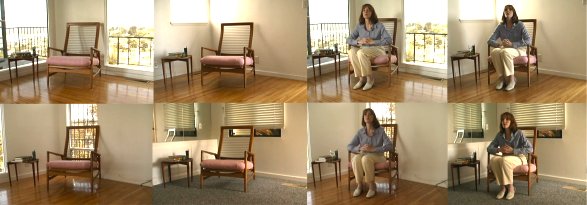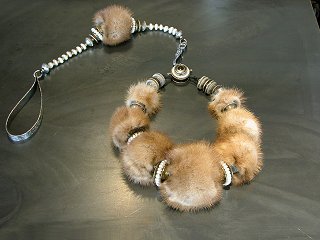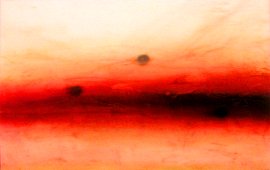ARTnews
Three Seattle Reviews
Gregory Kucera
Greg Kucera, Seattle
An aspiring king of all media, Gregory Kucera (no relation to the gallerist) displays virtuosity with sculpture, photography, video installation, and digital prints in his ambitious, tightly thematic first showing at the gallery. The Los Angeles artist makes short films and digitally averages their imagery into horizontal bands of color, then prints and seals the resulting captures in Plexiglas sheets. The effect recalls Tim Bavington’s rock-and-roll-inspired stripe paintings, but with a more marked juxtaposition of hard line and airbrush-like gradation. Kucera’s sculpture, Temporal Relief, is a negative-space inversion of an L.A. city block used in another video installation. It’s an agreeably odd piece fashioned from white polyurethane and resin. Looking for all the world like a giant petrified marshmallow, it protrudes pointily here and there, its architectural details tiny stalactites of white goo frozen mid-melt.
The artist’s perforated cast acrylics have holes bored through their surfaces, such that from afar, the holes pixelate into a tableau of chair and end table. In turn, this furniture makes another appearance in the show’s pièce de résistance, a video installation called Tina: Spatiotemporal Reconstruction 2. The chair and table are configured in the same spot in four different living rooms, with a blandly dressed woman walking into each room, sitting down, and arguing with a lover over the phone. After intersplicing these scenarios at a leisurely pace, Kucera ratchets up the editing to dizzying speeds, making for a disorienting yet strangely comforting scene. No matter our environment, the artist seems to posit, we—and our banalities—remain the same.
—Richard Speer
Nancy Worden
William Traver, Seattle
In Modern Artifacts, Nancy Worden bedecks ten mannequins with fanciful necklaces that not only encircle the neck, but also cascade down the back. She terms these works “exosquellettes,” for they are meant to evoke body armor and protect their wearers against what she calls the “spiritual osteoporosis in many middle-aged women.” Notable for their inventive exploitation of unlikely materials, the pieces deploy clothespins, keys, coins, and Native American love beads in the artist’s mission to meld visual allure and sociopolitical commentary. One work, Inanna’s Laugh, uses 23-karat gold, copper, and fresh roses to recall an Ancient Sumerian fertility goddess, while Frozen Dreams splashes glacial pools of etched acrylic across the bodice. The show’s wittiest statement is The Leash, which, with its mink and pearls, at first appears to be a luxurious stole. But hanging down the backside is the leash that gives the work its title—and its metaphoric bite.
Each piece is accompanied by an explanatory card explaining its symbolism. This is helpful in showing the layers of meaning beneath the necklaces’ showy surfaces, but it risks demystifying these enchanting objects with overly pat simplifications. Lifting Weights, for example, is made of tiny lead fishing weights strung together with gold, silver, and ebony. “This,” the card informs us, “is an apparatus to enable the wearer to balance the expectations that others have of her with her own needs and desires.” Easily rising above the prosaica of costume or jewelry design, these objets d’art needn’t be so ponderously literalized. With their blend of delicacy and acid wit, Worden’s artifacts speak quite capably for themselves.
—Richard Speer
Mark Rediske
Foster/White Gallery, Seattle
In his show at Foster/White, Mark Rediske bridges working methods and pictorial styles, transitioning from his customary figurative imagery into realms of abstraction. In his more traditional work, the artist has long aimed to use “botanical, vessel, and avian imagery” to “form a vocabulary of universal beauty.” And indeed, his panels, often encaustic, overlap layers of stencil-like traces and heavy shading to portray plants, vases, and iconic birds, conjuring Platonic, vaguely Rosenkavalier-esque matings of arid neo-classicism and rococo excess. In Mirror, Rediske lines up five panels in a row as a kind of summa of this technique, while other works with self-consciously antiquarian titles like Knossos and Ancient Illumination strike a note of archetypal familiarity.
Perhaps sensing that this familiarity may, by now, be softening into over-familiarity (especially given the lullingly muted bones and beiges in his palette), the painter has wisely seen fit to shake things up a bit, breaking from his previous work via gestural lines and asymmetric compositions. The new works display a fluid marbling of paint, a free-form yet subtly controlled color seepage that dispenses with the need for literal referents and is richer for it. Even these paintings, though, have not entirely slipped the surly bonds of earth. With their horizontal orientations, their suggestion of clouds meeting land or sea at the picture planes’ middle axes, the works evoke abstracted landscapes—perhaps not of any known terrain, but of the artist’s unfettered imagination.
—Richard Speer
BACK TO RICHARD'S ARTNEWS REVIEW MENU
BACK TO RICHARD'S WELCOME PAGE
BACK TO RICHARD'S RESUME


